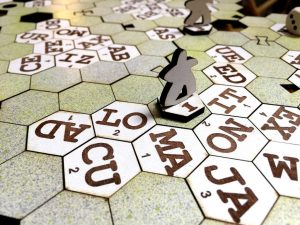”Ahány nyelv, annyi ember” – Thoughts on Language and Multilingualism – Multilingual Monday Blog Series, 3

This blog series focuses on discussing multilingualism and multiculturalism specifically from four different perspectives: linguistic and cultural repertoire, linguistic and cultural landscape, the connection between language and culture, and the identity of a multilingual person. Blogs will be published once a week on Mondays until May 9, 2022. Blog 1: Multilingualism and Multiculturalism as a Phenomenon, Blog 2: Linguistic Repertoire From the Perspective of a Multilingual Person.
Blog 3: Thoughts on Language and Multilingualism
”As many languages, as many minds” – is a loose translation of the Hungarian proverb in the title. The saying suggests that when you know many languages, you also renew mentally and spiritually. Every language you learn opens up new perspectives on looking at the world and deepens your understanding of reality. Language reflects culture and culture reflects one’s mindset. Language shapes thinking, and thinking in turn shapes human activity and society.
Power of Words
In the national epic of Finland – Kalevala (Lönnroth, [1849] 2005) – there is talk of the power of words. Väinämöinen needs luotes – meaning magical words or lyrics – to build a boat. The giant Antero Vipunen refuses to give them, so Väinämöinen visits his belly to find the deepest and most secret information (SKS 2022).
As mentioned above, luotes refer to magical, powerful words or lyrics in Finnish folk poetry (Kotus 2021). They were revered and held sacred. The word is also etymologically interesting. The original Finnish word luote possibly contains the verb trust in Finnish – luottaa. If so, this would suggest that the words of the powerful spells were confidential information and in the possession of only a few. Lönnroth (1880) himself speculated that loitsu – the Finnish equivalent for the word spell – is derived from the Sámi language.

I am a professional ethnographer and linguist, so my interest in words and their meanings is unquenchable. I have read the Kalevala several times and studied the translations of its texts (see Kóbor-Laitinen 2007). My bookshelf contains volumes of the Kalevala in many different languages and from different decades. I consider the Kalevala a linguistic and cultural treasure chest where you can find empowering solutions and cures for all sorts of puzzles and issues. One of the most famous parts of the Kalevala is the third poem in the collection, in which Väinämöinen sings Joukahainen into a swamp. Similar battles of song can be seen in, for example, political elections and rap battles. Words have eternal power. They can heal, but also destroy.
Language Games
Philosopher Ludvig Wittgenstein (1889–1951) spoke about language games. Wittgenstein thought that the meaning of language is in its use. Understanding meaning equals the ability to use language in a particular community (Mäntysalo & Nyman 2012). According to Wittgenstein, language games are thus socially and situationally determined communication practices in which the concrete collaborative nature of language is emphasized. This also means that the use of language is always associated with power and responsibility.

Today, there is talk of language awareness and languaging, but these phenomena are not new (see, for example, Jørgensen, Karrebæk, Madsen, Møller 2011; Lilja, Luukka and Latomaa 2017; Turja 2019). According to Wittgenstein, it can (still) be said that the whole of human life is made up of various language games, which, in addition to the use of linguistic expressions, also include other acts and deeds of the language user. Understanding language and the culture associated with it is impossible if we are not aware of our involvement and role in the language game or if we do not recognize the context and discourse of the current interaction.
It Goes Without Saying?
There is a lot of tacit knowledge involved in language use. Tacit knowledge means that requirements, practices, and conventions related to language use are often not spoken or written about. They are learned gradually through observation (Svinhufvud 2007, 108). The fact that this information is not disclosed is usually not intentional. In terms of interaction, language games or languaging are part of every person’s life. Unwritten rules and practices regarding language and culture are best learned by participating in interactive encounters.

The concept of languaging (Jørgensen et al. 2011) is based on the assumption that all people are languagers. Linked to this is the idea that division into monolinguals, bilinguals and multilinguals is not needed. Separate languages are ideological constructions and the boundaries of languages are socially constructed. In terms of interaction, perceptions of who owns the linguistic resources and whom or what they are associated with are more important than structural differences between languages.
New Language, New Me
Languages also shape our identity. Translated word for word, the Hungarian proverb in the title says that “you are as many people as many languages you have”. Learning a language is also about getting to know the culture, customs and rules of behavior of the people who speak it. When you get to know a language and culture that is foreign to you with an open mind, you also get more diverse tools for thinking. Knowledge of languages and cultures enriches you spiritually as well as mentally and gives you the ingredients to build your own personality. By learning new languages, one becomes more than a lonely soul who sees the world only in one certain way.
References
Jørgensen, J. Normann, Karrebæk, Martha Sif, Madsen, Lian Malai & Møller, Janus Spindler 2011. ”Polylanguaging in Superdiversity”. Diversities Vol. 13, No. 2, 23–37. Accessed 25.2.2022. https://citeseerx.ist.psu.edu/viewdoc/download?doi=10.1.1.452.8518&rep=rep1&type=pdf
Kóbor-Laitinen, Zita 2007. ”Kalevala suomalaisella viittomakielellä”. MikaEl, Vol. 1. Kääntämisen ja tulkkauksen tutkimuksen symposiumin verkkojulkaisu. Jarmo Harri Jantunen, Minna Kumpulainen & Tuija Luokkakallio (ed.) Accessed 25.2.2022 https://www.sktl.fi/@Bin/41131/Kobor-Laitinen.pdf (In Finnish)
Kotus 2021. Kotimaisten kielten keskus. Nykysuomen sanakirjan näköisjulkaisu, p. 265. Accessed 28.2.2022. https://kaino.kotus.fi/ns/Nykysuomen_sanakirja_3_L-N.pdf (In Finnish)
Lilja, Niina & Luukka, Emilia & Latomaa, Sirkku 2017. ”Kielitietoisuus eriarvoistumista jarruttamassa”. AFinLA Yearbook (75), 11–29. Accessed 27.2.2022. https://journal.fi/afinlavk/article/view/66742 (In Finnish)
Lönnroth, Elias [1949] 2005. Kalevala, 32. edition. Helsinki: The Finnish Literature Society, SKS. (In Finnish)
Lönnroth, Elias [1880] 2008. Suomen kansan muinaisia loitsurunoja. The Finnish Literature Society, SKS. Näköispainos. Helsinki: Salakirjat. (In Finnish)
Mäntysalo, Raine & Nyman, Kai 2012. ”Suunnittelu kielipelin politiikkana”. Yhdyskuntasuunnittelu, Vol. 50:4, 33‒51. (In Finnish)
Siikala, Anna-Leena 2014. Itämerensuomalaisten mytologia. Helsinki: The Finnish Literature Society, SKS. (In Finnish)
SKS 2022. Matkalla Kalevalaan. Accessed 27.2.2022. https://matkallakalevalaan.finlit.fi/kalevalan-kuka-kukin/kalevalan-henkil%C3%B6it%C3%A4 (In Finnish)
Svinhufvud, Kimmo 2007. Kokonaisvaltainen kirjoittaminen. Helsinki: Tammi. (In Finnish)
Turja, Hanna-Kaisa 2019. ”Monikielisyys, kielitietoisuus ja kielelliset maisemat”. In Satu Riikonen ja Hanna-Kaisa Turja (ed.) Töissä täällä – Näkökulmia maahanmuuttajien työllistymiseen. https://www.humak.fi/wp-content/uploads/2019/09/toissa-taalla-nakokulmia-maahanmuuttajien-tyollistymiseen.pdf (In Finnish)
Text: Zita Kóbor-Laitinen, Lecturer, FM, KM (M.A.), Sign Language Interpreter (UAS)
Translation: Mari Ervasti

